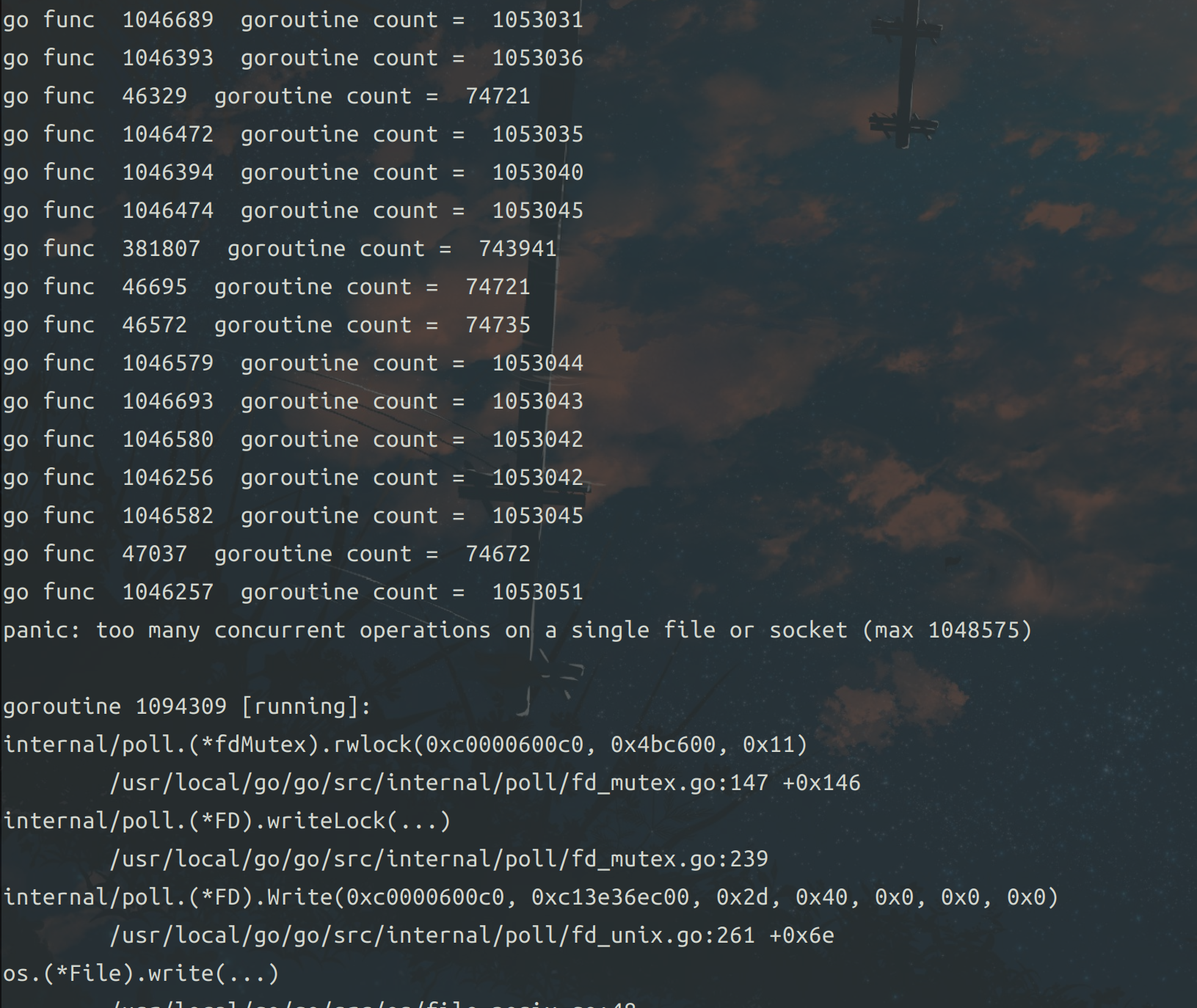Go可以无限go下去吗
前一段时间看到知乎上的一个问题,Golang 开发需要协程池吗? 看了知乎上大佬上的一些回答,大部分人的回答都是不需要,不过这里我也想表达一下自己的看法。

首先先总结一下这个问题下面各个知乎网友们的答案;
- silsuer:这层的回答是肯定了协程池的作用,极限的性能压榨,复用goroutine减少重新创建也是可以接受的。所以是赞同协程池的。当让如果是个小项目就没必要搞什么协程池了。大型并发服务就需要慎重考虑了。(这个比较中肯)
- Angry Bugs:这层的回答是显然不需要协程池,因为他认为池化主要是为了解决频繁创建的开销,而goroutine已经够轻量级别。
- 千言千语:这层的回答也是认为大部分场景下是不需要goroutine的,Go 语言自出生就身带“高并发”的标签,其本身就拥有及其优秀的并发量和吞吐量。
其他的答友基本上也都是反对协程池的概念。有提到小部分场景需要,但是又没有说的特别明白。因为Goroutine本身具备体积轻量、优质的GMP调度模型的特点,所以不需要协程池。
有关GMP调度可以参考我之前的文章:Golang GMP
说到池这个概念,我们接触最多的是线程池,那么我们先了解下什么是线程池
什么是线程池?
贴一个维基百科的解释。https://zh.wikipedia.org/wiki/%E7%BA%BF%E7%A8%8B%E6%B1%A0?wprov=sfti1
线程池 (英语:thread pool) :一种线程的使用模式,线程过多会带来调度开销,进而影响缓存局部性和整体性能。而线程池维护着多个线程,等待着监督管理者分配可并发执行的任务。这避免了在处理短时间任务时创建和销毁线程的代价。
说到这里,看起来大家对线程池的定义都主要是集中在是否可复用线程,减少线程创建、销毁的代价上。
协程可以无限创建吗?
知乎网友 @silsuer 说道协程池有一个作用就是限制协程过多,那么我们来看下 goroutine是否可以无限开辟呢,如果做一个服务器,或者高并发业务场景。能否可以随意开辟goroutine并且放养不管呢?毕竟有强大的GC和优质的GMP调度算法。
看下面的代码:
package main
import (
"fmt"
"math"
"runtime"
)
func main() {
//模拟用户需求业务的数量
task_cnt := math.MaxInt64
for i := 0; i < task_cnt; i++ {
go func(i int) {
fmt.Println("go func ", i, " goroutine count = ", runtime.NumGoroutine())
}(i)
}
}结果:

最终被操作系统强制kill掉了,强制终结了该进程。所以我们迅速的开辟goroutine(不受控的并发goroutine数量)会在短时间占据操作系统的资源(CPU、内存、文件描述符等)。这些资源实际上是所有用户态程序共享的资源,所以大批的goroutine最终引发的灾难不仅仅是自身,还会影响其他程序。
如何控制goroutine数量
方法一:通过一个channel 来控制 goroutine。
package main
import (
"fmt"
"math"
"runtime"
)
func work(ch chan bool, i int) {
fmt.Println("go func ", i, " goroutine count = ", runtime.NumGoroutine())
<-ch
}
func main() {
//模拟用户需求业务的数量
task_cnt := math.MaxInt64
//task_cnt := 10
ch := make(chan bool, 3)
for i := 0; i < task_cnt; i++ {
ch <- true
go work(ch, i)
}
}运行结果
go func 409202 goroutine count = 4
go func 409203 goroutine count = 4
go func 409204 goroutine count = 4
go func 409205 goroutine count = 4
go func 409206 goroutine count = 4
go func 409207 goroutine count = 4
go func 409208 goroutine count = 4
go func 409209 goroutine count = 4
go func 409210 goroutine count = 4
go func 409211 goroutine count = 4
go func 409212 goroutine count = 4
go func 409213 goroutine count = 4
go func 409214 goroutine count = 4
...goroutine被成功限制到并发3个(这里打印4是因为还有一个 main goroutine)。但是这里实际上是限制了并发速度的。
程序执行的速度取决于 work() 函数的执行速度,这样实际上,同一时间内运行的goroutine的数量与channel限制buffer的数量一致了,从而达到限定效果。
不过这个代码有个小问题,就是如果 go_cnt 的数量如果变得小一点,就会出现打印的结果不正确的情况。
package main
import (
"fmt"
"runtime"
)
func work(ch chan bool, i int) {
fmt.Println("go func ", i, " goroutine count = ", runtime.NumGoroutine())
<-ch
}
func main() {
//模拟用户需求业务的数量
//task_cnt := math.MaxInt64
task_cnt := 10
ch := make(chan bool, 3)
for i := 0; i < task_cnt; i++ {
ch <- true
go work(ch, i)
}
}打印结果:
go func 2 goroutine count = 4
go func 3 goroutine count = 4
go func 4 goroutine count = 4
go func 5 goroutine count = 4
go func 0 goroutine count = 4
go func 6 goroutine count = 4
go func 7 goroutine count = 4这是因为 main 将全部的 goroutine 开辟完成之后就直接退出了,如果希望所有的main都执行需要阻塞掉main。
方法二:添加 sync.WaitGroup
import (
"fmt"
"math"
"sync"
"runtime"
)
var wg = sync.WaitGroup{}
func work(ch chan bool, i int) {
fmt.Println("go func ", i, " goroutine count = ", runtime.NumGoroutine())
<- ch
wg.Done()
}
func main() {
//模拟用户需求业务的数量
task_cnt := math.MaxInt64
for i := 0; i < task_cnt; i++ {
wg.Add(1)
ch <- true
go work(i)
}
wg.Wait()
}方法三:利用无缓冲 channel 与任务发送\执行分离的方式。
package main
import (
"fmt"
"math"
"sync"
"runtime"
)
var wg = sync.WaitGroup{}
func work(ch chan int) {
for t := range ch {
fmt.Println("go task = ", t, ", goroutine count = ", runtime.NumGoroutine())
wg.Done()
}
}
func sendTask(task int, ch chan int) {
wg.Add(1)
ch <- task
}
func main() {
ch := make(chan int) //无buffer channel
goCnt := 3 //启动goroutine的数量
for i := 0; i < goCnt; i++ {
//启动go
go work(ch)
}
taskCnt := math.MaxInt64 //模拟用户需求业务的数量
for t := 0; t < taskCnt; t++ {
//发送任务
sendTask(t, ch)
}
wg.Wait()
}执行结果:
go task = 261428 , goroutine count = 4
go task = 261430 , goroutine count = 4
go task = 261434 , goroutine count = 4
go task = 261435 , goroutine count = 4
go task = 261433 , goroutine count = 4
go task = 261432 , goroutine count = 4
go task = 261438 , goroutine count = 4
go task = 261437 , goroutine count = 4
go task = 261440 , goroutine count = 4
go task = 261441 , goroutine count = 4
go task = 261442 , goroutine count = 4go协程池
说到这里,可能大家已经知道了,协程池还是需要的,但是go 中的协程池不再是重要为了解决协程频繁创建销毁的性能问题了。
gorouting 是一种轻量级用户态线程,可以在线程的基础上实现分时复用,适用于IO密集型应用,goroutine 具有轻量、资源占用小、切换开销小的优势,但是受资源限制,协程创建的数量也是有限的,过多的创建协程,会导致程序消耗过多的系统资源,从而影响程序的正常运行。
ants是一个广泛使用的goroute池,可以有效控制协程数量,防止协程过多影响程序性能。
ants 介绍
ants 协程池使用起来非常简单,支持默认协程池 defaultAntsPool、自定义协程池 NewPool(size, options)、指定方法协程池 NewPoolWithFunc 。
// 使用默认的协程池
_ = ants.Submit(func() {
fmt.Println("hello")
})
// 使用自定义协程池
p, _ := ants.NewPool(1000)
_ = p.Submit(func() {
fmt.Println("hello")
})
// 使用指定方法的协程池
p, _ := ants.NewPoolWithFunc(1000, func(i interface{}) {
fmt.Println(i)
})
_ = p.Invoke(Param)实现原理
在 antsPool 协程池中,每一个worker 对应一个 gorouting。在worker的初始化阶段会通过 go 关键字创建一个 gorouting,然后这个 gorouting 会不断监听并且执行 taskChan 里面的task,类似上面的方案三。
ants 的使用
- Pool
import (
"fmt"
"sync"
"sync/atomic"
"time"
"github.com/panjf2000/ants/v2"
)
func demoFunc() {
time.Sleep(10 * time.Millisecond)
fmt.Println("Hello World!")
}
func main() {
// 释放ants的默认协程池
defer ants.Release()
var wg sync.WaitGroup
// 任务函数
syncCalculateSum := func() {
demoFunc()
wg.Done()
}
for i := 0; i < 100; i++ {
wg.Add(1)
// 提交任务到默认协程池
_ = ants.Submit(syncCalculateSum)
}
wg.Wait()
fmt.Printf("running goroutines: %d\n", ants.Running())
fmt.Printf("finish all tasks.\n")
}- PoolWithFunc
import (
"fmt"
"sync"
"sync/atomic"
"time"
"github.com/panjf2000/ants/v2"
)
var sum int32
func myFunc(i interface{}) {
n := i.(int32)
atomic.AddInt32(&sum, n)
fmt.Printf("run with %d\n", n)
}
func main() {
// 初始化协程池
p, _ := ants.NewPoolWithFunc(10, func(i interface{}) {
myFunc(i)
wg.Done()
})
// 释放协程池
defer p.Release()
// 提交任务
for i := 0; i < runTimes; i++ {
wg.Add(1)
_ = p.Invoke(int32(i))
}
wg.Wait()
fmt.Printf("running goroutines: %d\n", p.Running())
fmt.Printf("finish all tasks, result is %d\n", sum)
}ants 协程池的配置
ants 协程池支持以下配置项:
- 协程池大小设置
- worker 协程过期时间,过期后的协程会被清理
- 内存预分配,是否初始化Pool的时候分配worker资源
- 最大阻塞任务数,默认0,任务阻塞知道分配到worker;当非0时,达到最大任务数,不执行任务并返回 overload
- 非阻塞提交,默认否,任务无worker执行时阻塞,当为true时,无worker则立即返回overload
- 自定义 panic 处理函数
- 自定义日志函数
代码片段:
// 设置配置项
options := Options{}
options.ExpiryDuration = time.Duration(10) * time.Second
options.Nonblocking = true
options.PreAlloc = true
// 初始化
poolOpts, _ := NewPool(10, WithOptions(options))